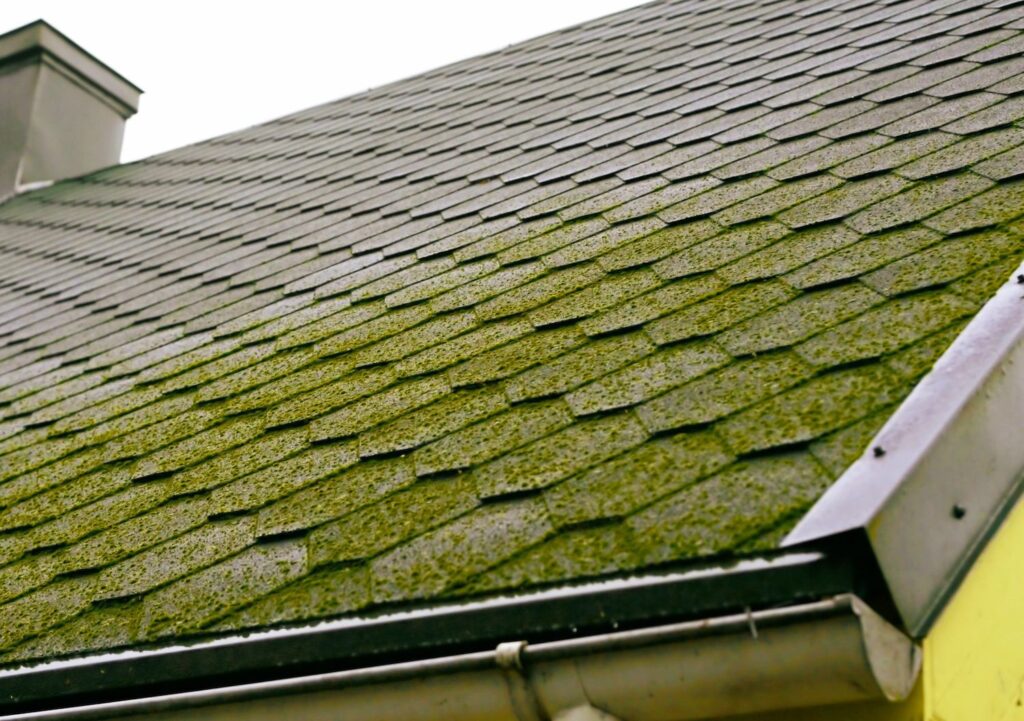A roof covered in moss might look quaint in storybooks, but in real life, it’s a pricy repair just waiting to happen—removal is essential. Moss holds moisture against your roof, making it easier for shingles to crack, curl, or rot. Over time, that can lead to serious damage and even impact the home’s curb appeal.
For anyone thinking about selling or just wanting to protect their investment, keeping moss at bay is key. This guide walks you through simple, effective, inspector-recommended ways to remove moss safely and prevent it from coming back.
Why Roof Moss is a Problem
Moss on a roof might seem harmless at first, but it can create serious issues if ignored. Moss grows in damp, shaded areas, thriving in environments where moisture lingers.
This might not sound like a big deal, but moss traps water against your roof, making it harder for shingles to dry out. Over time, the moisture can lead to cracking, curling, or rotting shingles.
Beyond damaging the roof’s surface, moss can also harm the underlayment, which is the protective layer beneath the shingles. When that happens, water can seep into the home, causing leaks, mold, and costly repairs.
For homeowners preparing to sell, moss-covered roofs can turn off potential buyers, lowering curb appeal and raising red flags during inspections. In short, keeping moss under control isn’t just about appearance but about preventing long-term damage and protecting investments.
How to Safely and Effectively Remove Roof Moss
Removing moss from your roof doesn’t have to be complicated, but it does require the right approach to avoid damage.
These steps will help you remove moss safely:
- Use a soft brush or broom to gently loosen and sweep away moss. Avoid scrubbing too hard, as this can damage shingles.
- Apply a moss-killing solution specifically designed for roofs. Avoid household cleaners or harsh chemicals that can strip protective coatings.
- Let the solution sit as directed, then rinse it off with a garden hose using low pressure. High-pressure washers can dislodge shingles and cause more harm than good.
- Clean gutters afterward to ensure proper drainage and prevent moss spores from spreading.
For safety, wear slip-resistant shoes, use a stable ladder, and work on a dry, clear day. If your roof has extensive moss, steep angles, or other challenges, consider hiring a professional who can remove moss safely and inspect for other damage.
From there, regular maintenance afterward can keep it from coming back and keep your roof strong and appealing—we\’ll cover that in more detail in a bit.
Preventing Roof Moss Growth
Stopping moss before it becomes a problem is the most effective way to protect your roof and avoid unnecessary repairs.
Moss thrives in damp, shaded environments, so a few preventative measures can make all the difference.
- Trim overhanging branches: Shaded roofs are moss magnets. Cutting back tree limbs lets sunlight reach your roof and reduces moisture buildup.
- Keep gutters clear: Clogged gutters trap water along your roofline, creating the perfect conditions for moss growth. Regular cleaning ensures proper drainage and helps keep moss at bay.
- Install zinc or copper strips: These metals naturally deter moss. When rainwater runs over them, it releases particles that create an environment where moss struggles to grow.
- Inspect and clean the roof regularly: Remove debris like leaves, twigs, or dirt that can trap moisture and give moss a foothold. A quick seasonal sweep can prevent bigger problems down the line.
- Check for early signs of moss: Addressing moss while it’s still small and manageable can save time and money compared to dealing with widespread growth.
Other Maintenance
While keeping moss under control is important, removal is just one piece of the puzzle for a healthy roof. A few additional maintenance tasks can help preserve your roof’s condition and extend its lifespan!
- Inspect your roof periodically for missing or damaged shingles and address any issues promptly.
- Clean your roof and gutters after storms to prevent debris buildup.
- Check your attic for signs of leaks or water damage, as these can indicate roof problems.
- Ensure your roof ventilation system is functioning properly to prevent moisture buildup.
When to Call a Professional
If moss has spread across large sections of your roof, has been there for a long time, or if you’re unsure how to remove it safely, calling a professional is the smart choice.
Experts have the tools and experience to get rid of moss without harming your roof, and they can spot issues like damaged shingles or leaks that might otherwise go unnoticed.
Professional help is also a good idea for roofs that are steep, tricky to access, or showing signs of deeper problems, such as water stains or sagging areas. Trying to handle these situations on your own can be dangerous and could lead to costly mistakes.
An expert can evaluate the overall condition of your roof, recommend prevention strategies, and ensure your home is protected. Whether you’re sprucing up your home for sale or just keeping it in top shape, investing in preventative steps can save you time, stress, and future repair bills.
Conclusion
Whether you’re preparing your home for sale or simply taking care of your investment, staying proactive makes a big difference. If moss has already taken hold or you’re unsure about the state of your roof, professional help can provide expertise and guide you toward removal.
At Champia Real Estate Inspections, we’re here to help you safeguard your home. Our experienced inspectors can assess your roof, identify potential concerns, and provide recommendations in Atlanta and surrounding areas—reach out today!

